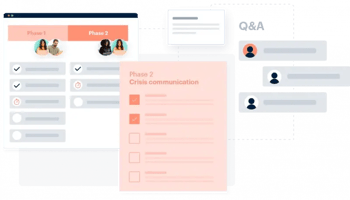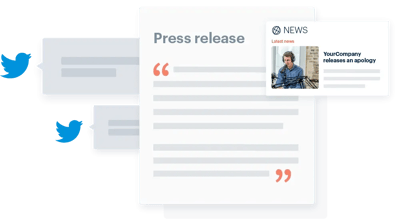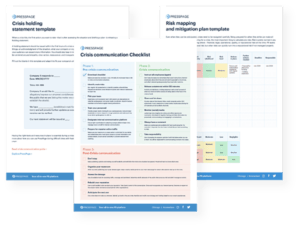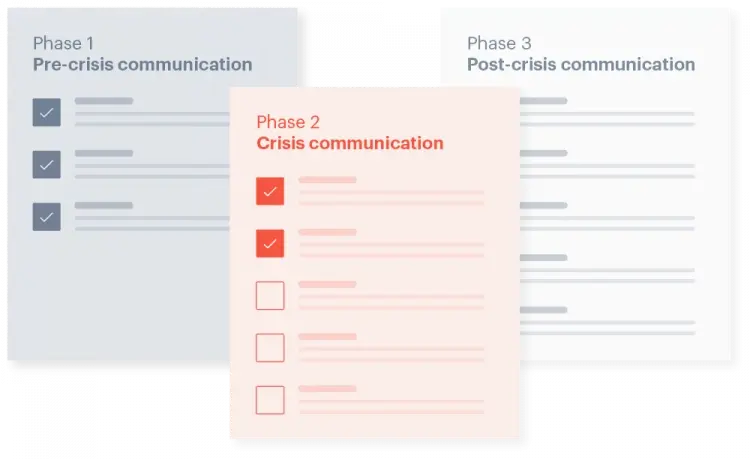Introduction
If COVID-19 taught us anything, it’s that no organization is immune from a crisis. For Public Relations teams, the question is not how to avoid crises, but how to manage them effectively when they arise.
The main goal of crisis communication management is to protect your organization’s reputation. This usually involves engaging with the media and the public in an open way and giving them information that is accurate and has been validated by experts.
When it comes to a crisis, preparation is everything. Teams must be adequately trained, and have some practice in simulated crises in order to perform effectively when a real one comes along.

1. What is a crisis?
In short, a crisis is an unexpected event that has the potential to negatively impact your company’s reputation. A crisis is the ultimate test of your brand equity. When everything is going well, it’s relatively easy for a strong brand to maintain a good relationship with the public. But what happens when a crisis breaks?
That could include everything from unfortunate tweets that leave your company looking crass or unprofessional to major operational crises where lives may be at risk, or the future of the organization is at stake.
Some examples of crises your company may have to deal with include:
- Operational disruptions that prevent you from offering your services
- High profile court cases were taken against your company
- Financial scandals
- A disaster at one of your factories or operational locations
- Accusations against your company or senior leadership
Depending on the nature of the crisis, the Public Relations team works closely with other internal stakeholders including Legal, HR, Health and Safety, and Operations to ensure a cohesive corporate response. The acronym PEARL can be used to determine corporate priorities in a crisis.
P – People: What people are impacted? They come first.
E – Environment: Is there an environmental impact?
A – Assets: How does this crisis affect the company’s assets?
R – Reputation: How can the team manage the impact on the company’s reputation?
L – Learnings: Afterwards, it’s important to look at any learnings
While reputation comes fourth on the list, it’s the item that is the primary responsibility of the PR team. It’s the Public Relations department’s responsibility to have a well thought out crisis communications and PR strategy ready as and when it’s needed. The plan should be documented in a written procedure, saved somewhere central so that it’s easy to access, and reviewed and updated every year.

2. Anticipating a crisis
On an annual basis, companies should complete a SWOT (Strength, Weakness, Opportunity, Threat) analysis with the aim of predicting any crises that might come up in the next 12 months.
The types of crisis that are likely to come up vary from company to company:
- An airline will always plan for a scenario where an aircraft fails
- A food production company might plan for a scenario where a batch of food needs to be recalled for health and safety reasons
- Manufacturing companies need to plan for product failures
- Software companies might identify their most likely crisis as the threat of a data hack.
It’s important to consult your leadership team as a whole in identifying what the top three or top five most likely crisis scenarios are, and putting a clear PR crisis plan in place to address them. Later in the guide, we’ll discuss the importance of crisis simulations – you can use your most likely crisis scenarios as the basis for these simulations.
Naturally, when a company knows what crises are likely to come up, they should take steps to mitigate against them. Prevention is better than cure when it comes to a crisis. But if prevention is not possible, a general awareness of the types of crises that might come up is very useful in planning.
Case Study: Getting it right during Covid-19ALDI, a German supermarket chain operating in Ireland, acted quickly to support all of its stakeholders during Covid-19. As well as implementing social distancing protocols to protect customers including limiting the number of shoppers allowed in-store, they also dedicated the hours of 11 a.m to 1 p.m for seniors who are especially vulnerable. Other shoppers were encouraged to visit the store outside these hours. |
Case Study: Getting it wrong during Covid-19At the outset of the Covid-19 outbreak in the UK, most companies followed government guidelines immediately and released public statements of unity. They emphasized that they were going to protect their staff and customers and that that was the top priority. However, Sports Direct attempted to argue against government advice by claiming that sports equipment was an essential service. There was an immediate backlash from the public who saw it as putting staff in danger and putting profits ahead of people. The impact was played out across the UK media and the move was also criticized by government officials. On social media, posters vowed not to shop at Sports Direct again. There was a significant amount of reputational damage on all channels. Mike Ashley, the owner of Sports Direct, eventually backed down and closed his shops. He and his team attempted to mitigate the damage by offering an apology, and by offering its fleet of trucks for use by the government. While an apology and mitigation was the right strategy once the crisis broke, the learning is that during a public health crisis, putting people first is essential. |
Brand and reputation
Your brand is the message you give the public about what you stand for, but reputation is the public’s interpretation of what you stand for. The public’s perception of an organization is vital to its ability to stay profitable. It’s important that your leadership team, products, and services have credibility. A crisis can threaten that, so it’s crucial that PR teams know exactly how to handle it when one comes up.
RepTrak releases a major global report each year ranking brands according to how strong their reputation is with consumers. In 2019, the top 10 companies worldwide were:

It’s no surprise that these are some of the most well-known household brand names in the world. These companies invest heavily in their brand year after year so that if a crisis hits, they have a bedrock of goodwill and credibility with the public.
RepTrak claims that this strong reputation creates an emotional bond between consumers and companies that can have a dramatic impact on the following:
- Whether consumers will buy your product
- If the general public would recommend your company
- Policymakers and regulators in giving you a license to operate
- The financial community’s willingness to invest in your organization
- How the media reports your point of view
- Whether employees deliver on your strategy
Working on your reputation during peacetime
One way companies have prepared for the impact of a crisis in ‘peacetime’ is through Corporate Social Responsibility (CSR), which includes community initiatives, charity partnerships, or environmental sustainability.
An example of this is Amazon’s decision to create a homeless shelter in Seattle. Big tech companies are often accused of gentrifying the areas they operate in so much that locals can no longer afford to live there. Amazon aims to mitigate against criticisms like that which could bubble up into crises by investing in the community.
More recently (and perhaps more effectively), CSR principles have been expanded by companies who tackle them holistically across their business model. This doesn’t mean that they will completely mitigate the risks they might face, but that their audiences are more likely to be forgiving – if they perceive their behaviour as authentic.
The difference lies in the company’s level of involvement with issues that their audiences or the public opinion might be concerned about. If journalists have started asking why most of your leadership team is male or caucasian, a traditional CSR approach would suggest you can anticipate controversies and counter them by supporting charities that promote diversity and inclusion. And while that can still come in handy, you might encounter backlash for not engaging with the subject internally. An even more effective approach could be to talk openly about why there is a lack of diversity, commit to it and outline a few of the steps you’re taking to get there.
Beyond its positive effect on your reputation, businesses that prove to be genuinely concerned about their impact can become more attractive to investors who include ethical impact and sustainability practices in their valuations, for example. Whichever actions you decide to take, make sure they can be traced back to your company values and connected to an action plan so you can talk the talk and walk the walk.
Media relationships and reputation
Another important consideration in maintaining a strong reputation is the company’s relationship with the media. If your CEO has never given an interview until the day a crisis breaks, journalists are likely to give them a hard time as an unknown quantity.
Similarly, if your leadership team has an adversarial relationship with the media, it’s likely you’ll face increased scrutiny and backlash when a crisis breaks. It’s a risky strategy and not one that is highly recommended.
On the other hand, if the PR team organizes exclusive interviews with key journalists several times each year, they will be on a first-name basis with many of the journalists covering the crisis and can expect more sympathetic coverage. Behind-the-scenes tours for journalists at factories, innovation hubs, and offices can also help to build relationships, as can roundtable discussions with journalists and senior management.
The goal is to create a collaborative, friendly atmosphere between your organization and the journalists who cover you so that you can draw on that goodwill if a PR crisis breaks.
Fail to prepare, prepare to fail
Preparing for a PR crisis is a sensible course of action for any Public Relations team. It can do untold damage to a company’s reputation if an inexperienced and untrained team is thrown in at the deep end. On the other hand, by managing a crisis well a company can see its shares rebound quickly and its credibility restored.
Running a simulation involving the PR team and all senior leaders is one of the best ways to prepare. Have one member of the team create a crisis scenario and simulate your response from start to finish. This will allow your company to find any gaps in your plans before a real crisis comes along.
Your team can practice creating holding statements at short notice, writing press releases and putting together all the materials senior managers need to do a press conference. The PR team can also create crisis checklists and internal FAQ documents.

3. What to do during a crisis
At the outset of the crisis, gather as much information as you can and develop a central document with Q&A, brief your team, and clarify their roles again. You may need to designate a room that is the ‘Command Centre’ of the crisis with senior members of the Operations, Legal, and PR teams working together to make key strategic decisions at the highest levels.
If you need to coordinate a company-wide response, make sure the messaging across all departments is consistent – a one-pager with the core message, key documents, and contact information should be enough.
The wider PR team should then operate from a breakout space in an adjacent office or area where they can be in constant contact with those in the Command Centre.
Crisis team: Roles and responsibilities
You need to know which members of your PR or Communications team will be responsible for handling crises well in advance. Any spokesperson who will have direct contact with the media needs to go through media training. In a crisis, it is more likely that your senior leaders will be your spokespersons than your PR team, so identify a shortlist of executives to go through the training annually.
Approved spokespersons should be documented clearly in your crisis response plan, as well as PR handlers with an explicit chain of command. Choose methodical thinkers who are likely to stay calm. PR team leaders and managers should be comfortable drafting statements and fielding calls from the news media, while more junior members of the team should be able to take on tasks like media monitoring and administration.
Any member of your PR team who is going to be involved in a crisis should also be fully trained up, even if they will not be the public face of the crisis. This training usually involves a mixture of learning the theory of crisis communication – like you’re doing right now – and going through simulated activities like preparing holding statements on the clock and rehearsal press conferences where public speaking skills can be honed.
Understanding your stakeholders
It’s important to define your audiences and their pain points, in order to acknowledge them, and speak with empathy, while being careful to not overpromise and underdeliver. It’s also key to map out all your stakeholders. These may include:
- The media
- The public
- Your clients and customers
- Your investors and shareholders
- Your employees
- Government or semi-state bodies
- Family or next-of-kin (in case of life-or-death scenarios)
Different audiences may need different messages. For example, when a company is making redundancies local journalists will care most about the impact the job losses will have locally, while business journalists nationally and internationally will report on the impact of stock prices.
For local journalists who will communicate the message to the community your company operates in, including the families of those made redundant, the most crucial thing to convey is empathy. On the other hand, shareholders will be most concerned about the value of their investment so it’s crucial to give business journalists the impression that everything is under the control at the company.
Internal updates
It’s important to keep your own employees informed during a crisis to avoid confusion. Communication updates (email, Intranet, company chat, etc.) should be shared with employees at the same time as any updated media statements are proactively issued. The same sentiments of care, control, and commitment should be contained within the employee update emails.
If there have been injuries and/or fatalities, further face-to-face engagements are likely to be required in order to provide reassurance and to demonstrate care and concern. These may be in the form of team briefings or larger town-hall meetings.
In each communication to employees, remind them that only approved spokespersons should speak to the press and that they should forward any enquiries to the PR team. Employees should not offer any kind of comment to members of the press who contact them directly.
Case Study: Reading the room wrongIn recent years, a number of brands have attempted to attach themselves to social movements with mixed responses. Pepsi was roundly lambasted for an ad in which Kendall Jenner brokers peace between protesters and police with a can of Pepsi, which was seen as a lazy and tone-deaf attempt to talk about #blacklivesmatter. Pepsi pulled the ad the next day. |
Publish a holding statement
A holding statement is exactly what it sounds like – a statement intended to hold the media at bay while you’re dealing with a crisis or incident. It provides a brief account of what the company knows and what actions it is taking in the face of the crisis at hand. The goal is to keep the public in the know and to protect your organization’s reputation.
It’s important to act with speed and confidence when an incident that threatens your reputation occurs. Your statement needs to be just right in terms of how it’s worded, but it also needs to be ready in minutes. Here are some tips for drafting solid statements:
- Try and include tangible actions (or ‘proof points’) that help you demonstrate the above three sentiments.
- Keep the three Ps in mind too: in any crisis response effort, people come first, then the planet (environment) and not profits.
- Never speculate: Include basic information and confirmed facts about the incident but as a general rule not why, it is likely that it will be too early to know the cause and a full investigation will follow)
- Don’t unnecessarily reveal commercially sensitive information
- If key facts are not known, this should be made clear and should not delay the drafting of the holding statement.
Always express:
Care and concern or anyone who has been affected (and/or for any environmental damage) – for example, ‘we regret to confirm three deaths at our factory during the earthquake’ or ‘we are deeply saddened that we must today announce redundancies’.
Control over the situation at the most senior level – for example, ‘every possible action is being taken to bring the situation under control’, or ‘an investigation has been launched and we are cooperating with the local government’.
Commitment to helping those affected and/or finding out the cause of the incident for example, ‘we are committed to finding out what has happened’.
Best practice suggests that a holding statement should be issued within 15 minutes of a crisis breaking, and an absolute maximum of one hour if the company wants to maintain control of the narrative.
One way to achieve this is to prepare a holding statement in advance, with some blanks left to fill in the details of the incident. Because holding statements are issued in the very early stage of a crisis, they are not generally detailed; they simply confirm that the company is aware of the crisis and proactively taking steps to manage it.
The crisis newsroom: How to lead your messaging in a crisis
Take a look at this blog to learn more on how to use your brand newsroom during a crisis.

4. Minimizing the impact on your reputation
The goal of crisis management is to handle any scenario that comes up with a robust strategy that minimizes reputational impact. Once the crisis passes, it’s important that your credibility as an organization remains intact, that the media accurately reports that the organization acted responsibly and fairly, and that consumer sentiment hasn’t turned against you.
Authenticity, openness and integrity are crucial to achieving this. If you need to let 500 employees go to save the company and the remaining 2,000 jobs, this is likely to be accepted by the public. But if the media reports that your top executives are taking huge bonuses while lower paid workers are losing their jobs, this will not play well and public outrage is likely.
Should a company apologize during a crisis?
It depends. Saying sorry at the appropriate time can be an important gesture – but it sends a clear message that the organization has done something wrong. As such, it can have wide repercussions including opening up the possibility of lawsuits. Apologies should be worded carefully, with advice from the company’s legal team.
Here’s an example of a holding statement with an apology. It comes from PWC, one of the world’s Big Four accountancy and professional services firms. At the Oscars 2017, LaLa Land was announced as Best Picture when the winner was, in fact, Moonlight. PWC were responsible for giving the presenters the correct envelope. They said:
|
We sincerely apologize to “Moonlight,” “La La Land,” Warren Beatty, Faye Dunaway, and Oscar viewers for the error that was made during the award announcement for Best Picture. The presenters had mistakenly been given the wrong category envelope and when discovered, was immediately corrected. We are currently investigating how this could have happened, and deeply regret that this occurred. - PWC |
Faced with the reality that they had made a huge mistake, PWC stepped up immediately and didn’t make excuses. They admitted their mistake, apologized and opened an investigation. They also expressed empathy and gratitude to those affected.
They went on to issue further statements clarifying what happened, and took full responsibility. As a result, the Board at the Oscars actually voted to retain them as their accounting firm, and PWC put new processes in place to ensure the same mistake never happens again.
Because they managed the crisis effectively, PWC retained a prestigious customer and minimized the damage to their reputation.

5. After a crisis
Learnings are a vital part of the crisis communications process. Any scenario that comes up once is likely to do so again – how can you be better prepared next time? The core team should be given the opportunity to give feedback on how the processes worked. Additionally, every team member who took part should receive individual feedback, and should be scheduled for more training if needed.
More importantly, however, a report should examine how the department handled the crisis as a whole. It should examine:
- The extent and tone of media coverage, online and offline
- What was the outcome in terms of the company’s reputation?
- Did public sentiment shift?
- What was the impact on share prices?
- How did the team’s pre-existing relationship with the media help or hinder your efforts?
- What was the internal feedback from senior management on how the PR team performed?
- What was the internal feedback from senior management on how the PR team performed?
In the weeks and months after the crisis has abated, these learnings should be used to update processes and procedures so that the company is well prepared for any future crisis.
Conclusion
World leaders like Jacinda Ardern in New Zealand and Finnish Prime Minister Sanna Marin have gained national and global credibility for their management of the COVID-19. They are embodying the principles of Care, Control and Commitment as they take decisive actions to prevent the spread of the virus. As a result, their credibility as leaders has only grown even in these extremely challenging times. This is largely due to clear communication and strong values working hand in hand.
Elsewhere, muddled messaging has left citizens confused, scared and angry, resulting in an increased spread of the virus, protests, and a drop in polls for the politicians responsible.
The next crisis to hit your organization may not be a global pandemic, but there are many lessons to be learned in crisis communications in how businesses and governments have responded to COVID-19.
Showing leadership, staying authentic, communicating openly and showing compassion are all crucial.

Get the crisis kit
The crisis communications kit includes a holding template, a risk assessment and mitigation template, and a crisis comms checklist.



